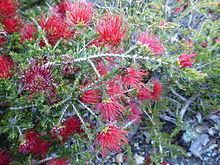Rank Species | ||
 | ||
Similar Beaufortia incana, Beaufortia micrantha, Beaufortia aestiva, Beaufortia decussata, Beaufortia schaueri | ||
Beaufortia cyrtodonta, commonly known as Stirling Range beaufortia, is a plant in the myrtle family, Myrtaceae and is endemic to the south-west of Western Australia. It is a compact shrub with crowded leaves which appear greyish due to their covering of fine, soft hairs. It has heads of red flowers in spring and occurs in the Stirling Range district.
Contents
Description
Beaufortia cyrtodonta is a compact shrub which grows to a height of 1.5 metres (5 ft). The leaves are linear, crowded and arranged in alternate pairs (decussate) so that they make four rows along the stems. The leaves are linear to lance-shaped, 4–7 millimetres (0.2–0.3 in) long and often have a covering of fine hairs, giving them a greyish appearance.
The flowers are red and are arranged in heads about 2.5 millimetres (0.1 in) in diameter on the ends of branches. The flowers have 5 sepals, 5 petals and 5 bundles of stamens. The bundles contain 3 stamens and are joined for 8.5–13.5 millimetres (0.3–0.5 in) with the free stamen ends a further 1.5–3 millimetres (0.06–0.1 in) long. Flowering occurs from June to November and is followed by fruits which are woody capsules 7–13 millimetres (0.3–0.5 in) long and clustered together.
Taxonomy and naming
Melaleuca cyrtodonta was first formally described in 1867 by Nikolai Turczaninow in Bulletin de la Societe Imperiale des Naturalistes de Moscou. In 1867, George Bentham transferred it to Beaufortia as Beaufortia cyrtodonta. The specific epithet ("cyrtodonta") is from the Ancient Greek kyrtos meaning "curved" or "bent" and odontos meaning "toothed".
Distribution and habitat
Beaufortia cyrtodonta mainly occurs in the Stirling Range district in the Avon Wheatbelt, Esperance Plains, Jarrah Forest and Mallee biogeographic regions. It grows in sandy and gravelly soils often derived from laterite on hills and outcrops.
Conservation
Beaufortia cyrtodonta is classified as "not threatened" by the Western Australian Government Department of Parks and Wildlife.
